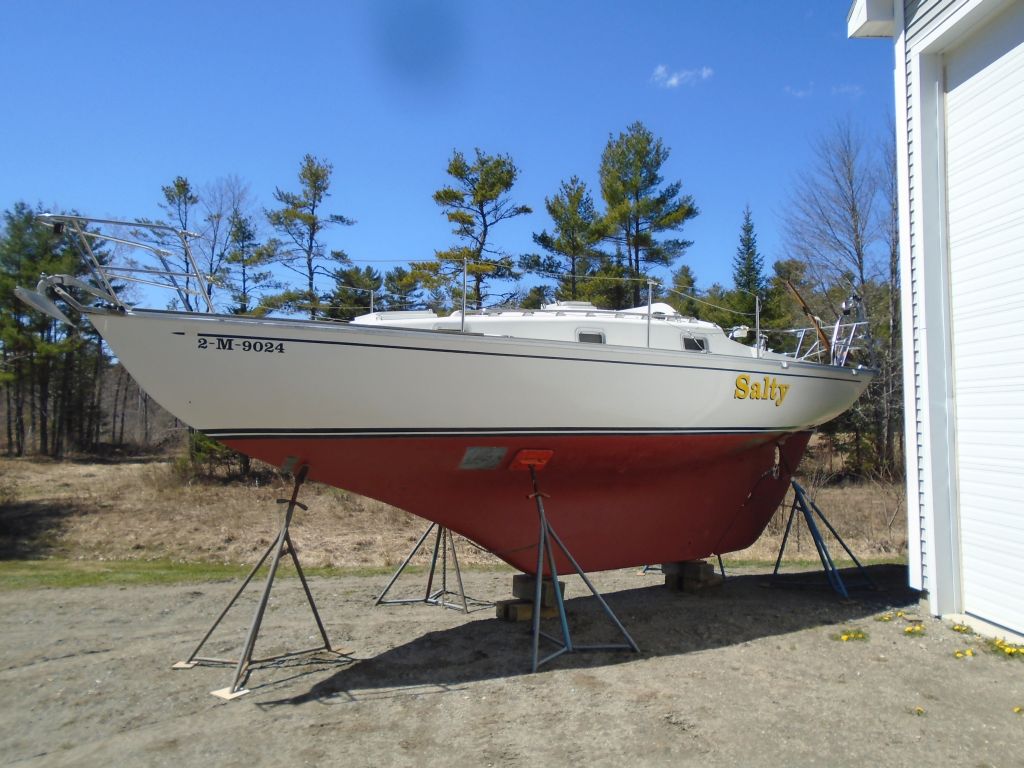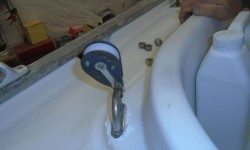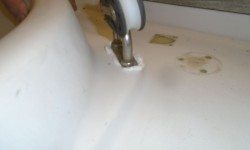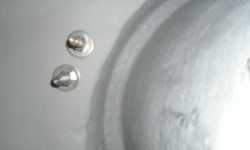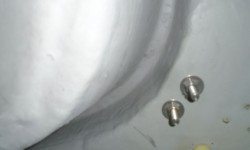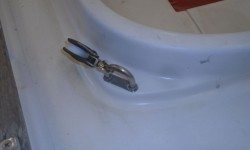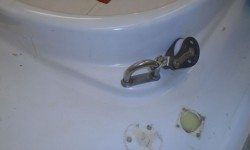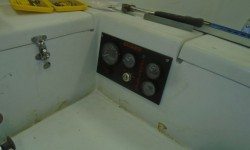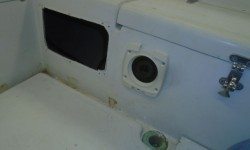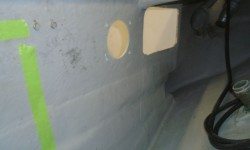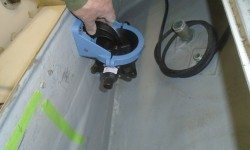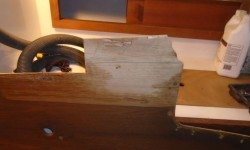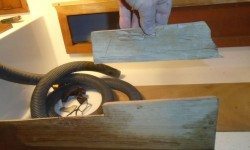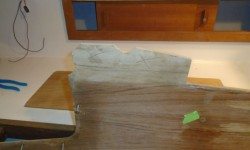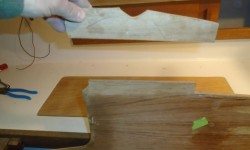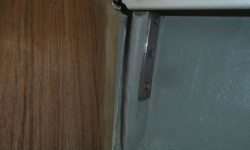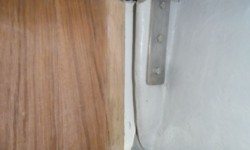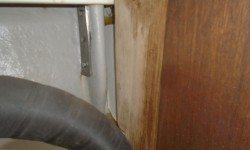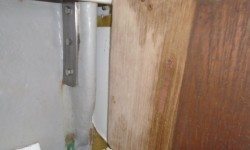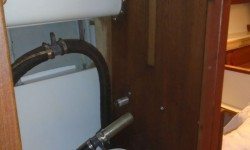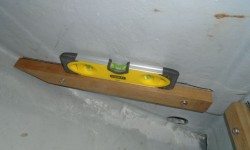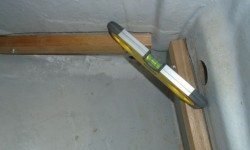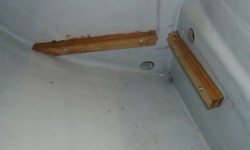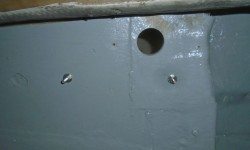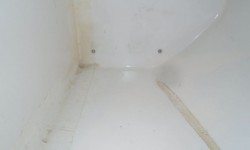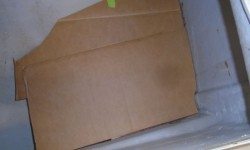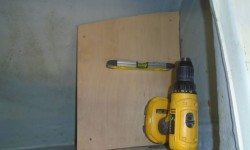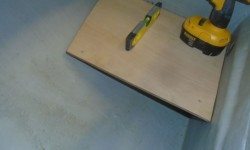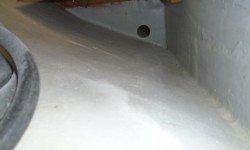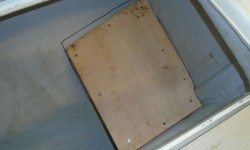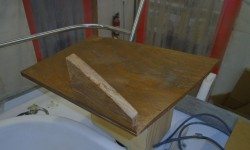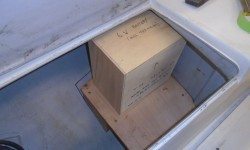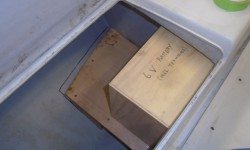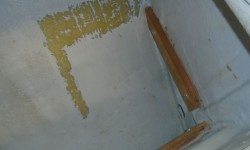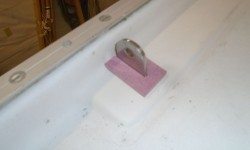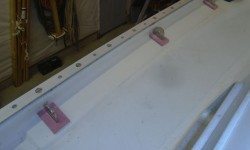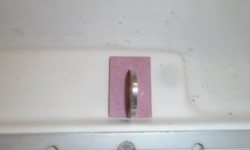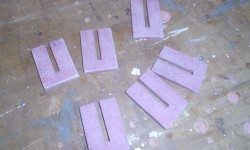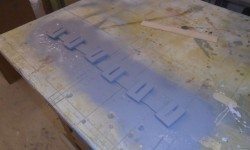March 15, 2016
Salty 17
Tuesday
To begin, I reinstalled the two mainsheet U-bolts at the aft end of the cockpit, with new sealant, nuts, and washers.
After marking the outline of the new opening with a pattern, I enlarged the old engine panel opening to accommodate the new panel, which I held in place temporarily with a couple screws for illustrative purposes only; I’d do the final installation a little later on, as it was too soon to put the panel in harm’s way.
Next door, I laid out the position of a new bilge pump, which would operate through the cockpit wall, and drilled the large hole and four fastener holes required. The cover plate, when installed, would align with the bottom of the engine panel next to it. I’d await installation on the pump till a bit later, to maintain good access in the locker to finish up some other installations first.
Now that the chainplates were back in place, I could reinstall the bulkheads and get things edging towards normal once again. After cleaning the installation areas once more, I checked the fit of one of the bulkheads to see if I could trim some of the excess material that interfered with access to the middle chainplates on both sides. I didn’t want to take out any material that might be important from a structural standpoint, but I found that the small tabs that extended into the narrow openings near the chainplate knees didn’t serve any such purpose. The structural liner, which formed the main interior cabinets and structures, was well-tabbed just aft of this position, inside the lockers above the galley. All the bulkhead fixing screws were well inboard of that area, and the bulkhead didn’t even contact the hull or molded overhead consistently in these slots, so I saw no reason why I could trim a bit in the hopes of providing someone better access in the future.
Leaving a full inch of overlap where this portion of the bulkhead passed over the last section of the molded interior liner, I trimmed the excess portion on each of the two bulkheads.
Next, I reinstalled the bulkheads. The shortened tabs did help with access to the chainplate bolts, though on the starboard side this was still going to be a challenge, but in any event access was now as good as it could be while the bulkheads were in place. I’d reinstall the cookstove vent and its cover once I’d reinstalled the deck fitting, which I’d only recently removed for rebedding.
Working now in the port cockpit locker, I did some final layout for the new battery platform, double-checking some measurements from my early mockup, and confirming that the boat was still level from side to side. Then, I made some level marks inside the locker, on both the forward (transverse) bulkhead and side (longitudinal) bulkhead, which lines I used to measure and install a pair of teak (from the scrap bin) cleats to support those two sides of the new platform. Once I had their positions set, I removed the gelcoat from the bonding surfaces, and secured the new cleats with epoxy and bolts through the bulkheads.
With these firm footings, I created a simple cardboard template of the space as needed, following the curvature of the hull outboard and the shape of the inner corners of the area. With my battery footprint mockup, and allowing extra room for cleats and so forth, I determined the final size and shape of the platform, and transferred the template to two pieces of 9mm plywood I had on hand; I planned to laminate the two pieces to make a suitably thick base. This design left good access beneath for locker drainage, and for access to a hole required for the bilge pump hose.
Satisfied with the shape of the platform, I prepared the bonding surfaces of the two sheets of thinner plywood, and epoxied them together, holding it secure with several screws as well. I scribed and cut a support cleat from additional teak to hold the after corner of the platform securely, and marked the bonding area on the hull during a dry fit, so I could remove the locker gelcoat from this area for the best bonding surface. I double-checked the fit of the “batteries” with my oversized plywood mockup, the height of which included ample room to account for the battery terminal height, so the fit appears closer than it actually is.
Preparations complete, I secured the platform with epoxy adhesive and screws to the cleats, and additional epoxy fillets where it met the hull at the outer corners, and beneath the teak “leg”. I finished up with a layer of biaxial tabbing to secure the platform to the hull, and epoxy-coated the top of the platform as well. The fillet got a little warm at its thickest point during curing, causing the change in color seen.
To round out the day, I built six fiberglass covers for the chainplates, each custom-fit to its respective location, as they were all just a bit different. Because the chainplates were so close to the short raised bulwark, there was not room for traditional deck plates to slip over the tops of the chainplates, so from a strip of 1/4″ x 1-1/2″ fiberglass I milled pieces with central slots that closely fit the chainplate width without binding, leaving them open at one end, and cut the length to leave a consistent reveal at the inboard edge. I beveled the lower edges where they met the bulwark as required to allow for a tight fit there.
With the basic fit complete, I lightly beveled the exposed corners for better appearance and coating retention, and on the insides of the slots I formed a small bevel to hold more sealant near the chainplate itself. Then, I sprayed on some primer to begin the coating process. I’d complete the installation once the covers were all painted.
Total time billed on this job today: 7.5 hours
0600 Weather Report:
35°, light rain. Forecast for the day: on and off rain and showers, high 45°


